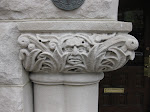 ation project presents unique challenges. When the project is a 20 minute boat ride into the Chesapeake Bay, the unique challenges are many. Yesterday Todd Anderson, Tyler Anderson and I set off on just that ride. We boarded the "Audacious" and set out with Capt. Howard Lewis, Henry Gonzalez of the U.S. Lighthouse Society and engineers from Keast and Hood Structural Engineers to spend the day planning out the restoration of the perimeter deck of the Thomas Point Shoal Lighthouse.
ation project presents unique challenges. When the project is a 20 minute boat ride into the Chesapeake Bay, the unique challenges are many. Yesterday Todd Anderson, Tyler Anderson and I set off on just that ride. We boarded the "Audacious" and set out with Capt. Howard Lewis, Henry Gonzalez of the U.S. Lighthouse Society and engineers from Keast and Hood Structural Engineers to spend the day planning out the restoration of the perimeter deck of the Thomas Point Shoal Lighthouse.Lighthouses, as you can imagine, suffer from extreme weathering. The decking and the joists holding the decking are rotting and much of the fabric needs to be replaced. Our task yesterday was to figure out how we would access the joists and replace them. Obviously, we can't just throw up ladders and scaffolding and go to town. A deck for the scaffold will have to be built and everyt
 hing will have to be properly secured. We also have to figure out how to get equipment and materials to the sight and where to store it once it is there.
hing will have to be properly secured. We also have to figure out how to get equipment and materials to the sight and where to store it once it is there.While restoring a lighthouse is not the norm, properly planning for a project should be. We've all forgotten something on a project: climbed a ladder and left your hammer at the bottom, or prepared half of a recipe and found out your out of cinnamon. If your working on a lighthouse you better have your Phillips-head screwdriver with you or its going to be a long trip back to the mainland! Proper planning at the beginning of a job can make everything run smoother. This doesn't just mean having the right tools on hand at the top of the ladder, but also making sure things are done in the right order. You want to make sure you don't have to backtrack. You can't install your wiring after the drywall is up. A successful job begins with careful planning.
As for the
 Lighthouse, the folks from Keast and Hood have investigated all of the joists, both visually and using a very cool resistance drill. We removed a couple of deck boards and verified what they had determined: that many of the joists have suffered from the exposure to the elements in the bay. We carefully studied the joists and how they were originally installed. Then we game-planned how we would remove the joists and reinstall new replacements. Obviously, when they were first put in, the rest of the building wasn't there. The installation of the replacements won't be as straight forward as it was when it was originally constructed. We have all the confidence in the world, however, that we can successfully replace the joists with proper planning!
Lighthouse, the folks from Keast and Hood have investigated all of the joists, both visually and using a very cool resistance drill. We removed a couple of deck boards and verified what they had determined: that many of the joists have suffered from the exposure to the elements in the bay. We carefully studied the joists and how they were originally installed. Then we game-planned how we would remove the joists and reinstall new replacements. Obviously, when they were first put in, the rest of the building wasn't there. The installation of the replacements won't be as straight forward as it was when it was originally constructed. We have all the confidence in the world, however, that we can successfully replace the joists with proper planning!So that is how we spent our day: learning as much as we could about a unique and very historically significant structure. Hopefully it was the first of many days spent out on the bay.





No comments:
Post a Comment